Performance Comparison of Geobroadcast Strategies for Winding Roads
Abstract
:1. Introduction
- Geounicast: conveys a message to the vehicle that is in a particular geographic position;
- Geobroadcast: conveys a message to all vehicles that are in a particular geographic area;
- Geoanycast: conveys a message to the nearest vehicle that is in a particular geographic area.
2. V2X Communication System
2.1. V2X Communication Modules
2.2. Ad Hoc Network Protocol
3. Implementation
4. Tests and Results
- Trajectory (top left): This graph shows the trajectory of the car (C) and the motorcycle (M) in UTM (Universal Transverse Mercator) coordinates (meters). The green line represents when both vehicles are connected (C knows M’s position) and the blue one when there is no connection between them. This disconnection may be caused because the car was out of the area defined in the GBC or because this message has not been received. The black point represents the position of the RSU module.
- GBC–Vehicle distance (top right): This graph shows the distance in meters between each vehicle with respect to the center of the GBC reception area. The green line represents the distance when the motorcycle has a connection with the car. The purple line represents the range of the GBC area, set at 100 m from the center in every case. The blue line is the evolution of the distance to the center of the motorcycle during the test and the red line is the evolution of this distance of the car. Finally, the red line represents the distance from the RSU module (when available) to the center of the reception area of the GBC.
- Vehicle speed (bottom left): This graph displays the speed of each vehicle in m/s. The red line represents the speed of the motorcycle and the blue line the speed of the car. Similar to the previous graphs, the color of the motorcycle line changes to green when there is communication with the car.
- Vehicle distance (bottom right): This graph shows the distance in meters between the vehicles and the RSU. The blue line represents the distance between the car and the motorcycle. The black line is the distance between the motorcycle and the RSU and the green line is the distance between the car and the RSU.
4.1. Validation without RSU Module
- Test 1 (Figure 5): The circular area 100 m in radius was focused on the motorcycle and the car remained immobile throughout the test.
- Test 2 (Figure 6): The configuration of the GBC messages was the same as for Test 1 but the car was moving in the opposite direction.
- Test 3 (Figure 7): The circular area 100 m in radius was focused on the vertex of the curve and the car remained immobile throughout the test.
- Test 4 (Figure 8): The configuration of the GBC messages was the same as for Test 3 but the car was moving in the opposite direction.
4.2. Validation with RSU Module
- Test 1B (Figure 9): The circular area 100 m in radius was focused on the motorcycle and the car remained immobile throughout the test.
- Test 2B (Figure 10): The configuration of the GBC messages was the same as for Test 1 but the car was moving in the opposite direction.
- Test 3B (Figure 11): The circular area 100 m in radius was focused on the vertex of the curve and the car remained immobile throughout the test.
- Test 4B (Figure 12): The configuration of the GBC messages was the same as for Test 3 but the car was moving in the opposite direction.
5. Discussion
- Test 1A: The rate of non-received packets during the test is high—about 25%. This is because the car remains in the same position throughout the test and does not receive messages from the motorcycle until it is within the line of sight of the bend, although the car is in the GBC range. Figure 5 shows that these losses occur mainly at the beginning and end of the entry into the GBC range, as the two vehicles are driven on the low visibility curve.
- Test 1B: By including the RSU module in the test, the number of packets that are not received is reduced by more than half, producing only sporadic packet losses; as can be seen in Figure 6, the car messages are received when the motorcycle enters the coverage area.
- Test 2A: In this case, the rate of non-received packets is also high, at around 27%. As in Test 1A, orography plays an important role in the test and the car takes longer to receive the first data from the motorcycle (it is at the opposite side of the curve) and there is no direct line of sight with the car. This data loss occurs at the beginning and at the end of the test, as shown in Figure 7.
- Test 2B: When including the RSU module, the number of packets that are not received is reduced by more than half, with the appearance of sporadic losses as shown in Figure 8.
- Test 3A: By selecting the center of the GBC range at the apex of the curve, the results are apparently worse since the rate of non-received packets during the test is 59%. This test is the one with the highest number of packets not received by the car. This is because the configuration of the GBC message causes the emission area to focus on the curve and, therefore, the car will always be within the broadcast area of the total packets emitted from the start of the trial.
- Test 3B: An RSU module is included, solving a part of the communication problem of Test 3A. The number of packets not received by the car is considerably reduced, although it is still high because they are calculated from the beginning of the trial, since the car is always stopped within the coverage area. As shown in Figure 10, the time during which the car receives messages is higher than for any of the above tests, as the car receives data packets at the same instant that the motorcycle has the direct vision line to the RSU module.
- Test 4A: In this case, the rate of non-received messages is high—around 51%—for the same reason as in Test 3A. As in other tests, the orography prevents communication between vehicles and this causes many messages to not reach the car.
- Test 4B: Finally, the best results occur with configuration 4B, where the rate of non-received packets is 4%. This gives the best result because the RSU module allows more efficient communication. It increases the range of communications and the car is in the coverage area when the motorcycle is connected with the RSU module, receiving the data. This setting is most appropriate when deploying a cooperative system and ensures that there will be maximum connectivity at the moment when there is greatest risk of an accident.
6. Conclusions
Acknowledgments
Author Contributions
Conflicts of Interest
References
- Jakubiak, J.; Koucheryavy, Y. State of the art and research challenges for VANETS. In Proceedings of the 5th IEEE Consumer Communications and Networking Conference, Las Vegas, NV, USA, 10–12 January 2008; p. 912. [Google Scholar]
- Intelligent Transport Systems (ITS). European Profile Standard for the Physical and Medium Access Control Layer of Intelligent Transport Systems Operating in the 5 GHz Frequency Band, v1.1.0 edition; European Telecommunications Standards Institute: Sophia Antipolis Cedex, France, 2009.
- 802.11p Local and Metropolitan Area Networks-Specific Requirements-part11: Wireless Lan Medium Access Control (mac) and Physical Layer (phy) Specifications Amendment 6: Wireless Access in Vehicular Environments; Technical Report; IEEE: Piscataway, NJ, USA, 2010.
- Hussain, R.; Son, J.; Eun, H.; Kim, S.; Oh, H. Traffic information system: A lightweight geocast-based piggybacking strategy for cooperative awareness in VANET. In Proceedings of the 2013 IEEE International Conference on Consumer Electronics (ICCE), Las Vegas, NV, USA, 11–14 January 2013; pp. 614–615. [Google Scholar]
- Atéchian, T.; Torbey, Z.; Bennani, N.; Brunie, L. CoFFee: Cooperative and inFrastructure-Free peer-to-peer system for VANET. In Proceedings of the 2009 9th International Conference on Intelligent Transport Systems Telecommunications, Lille, France, 20–22 October 2009; pp. 510–515. [Google Scholar]
- Prasetijo, A.B.; Alwakeel, S.S.; Altwaijry, H.A. Effects of VANET’s attributes on network performance. In Proceedings of the 2014 1st International Conference on Information Technology, Computer and Electrical Engineering (ICITACEE), Semarang, Indonesia, 8–9 November 2014; pp. 303–308. [Google Scholar]
- Meneguette, R.; Villas, L. An Autonomic Algorithm for Data Dissemination in Vehicular Ad Hoc Networks. IEEE Lat. Am. Trans. 2014, 12, 430–435. [Google Scholar] [CrossRef]
- Festag, A. Cooperative intelligent transport systems standards in Europe. IEEE Commun. Mag. 2014, 52, 166–172. [Google Scholar] [CrossRef]
- Observations on GeoNetworking, Document HTG1&3-3; Version: 2012-11-12, EU-US ITS Task Force, Standards Harmonization Working Group, Harmonization Task Groups 1 & 3; U.S. Department of Transportation: Washington, DC, USA, 2011.
- Korkmaz, G.; Ekici, E.; Özgüner, U. Urban multi-hop broadcast protocol for inter-vehicle communication systems. In Proceedings of the 1st ACM International Workshop on Vehicular Ad Hoc Networks, VANET ’04, New York, NY, USA, 1 October 2004; pp. 76–85. [Google Scholar]
- Durresi, M.; Durresi, A.; Barolli, L. Emergency broadcast protocol for intervehicle communications. In Proceedings of the 11th International Conference on Parallel and Distributed Systems, Fukuoka, Japan, 20–22 July 2005; Volume 2, pp. 402–406. [Google Scholar]
- Liu, Y.C.; Chen, C.; Chakraborty, S. A Software Defined Network architecture for GeoBroadcast in VANETs2. In Proceedings of the 2015 IEEE International Conference on Communications (ICC), London, UK, 8–12 June 2015; pp. 6559–6564. [Google Scholar]
- Queck, T.; Schünemann, B.; Radusch, I.; Meinel, C. Realistic Simulation of V2X Communication Scenarios. In Proceedings of the IEEE Asia-Pacific Services Computing Conference, Yilan, Taiwan, 9–12 December 2008. [Google Scholar]
- Djahel, S.; Jabeur, N.; Barrett, R.; Murphy, J. Toward V2I communication technology-based solution for reducing road traffic congestion in smart cities. In Proceedings of the 2015 International Symposium on Networks, Computers and Communications (ISNCC), Hammamet, Tunisia, 13–15 May 2015; pp. 1–6. [Google Scholar]
- Sandonis, V.; Calderon, M.; Soto, I.; Bernardos, C.J. Design and performance evaluation of a PMIPv6 solution for geonetworking-based VANETs. Ad Hoc Netw. 2013, 11, 2069–2082. [Google Scholar] [CrossRef]
- Zhenyu, L.; Lin, P.; Konglin, Z.; Lin, Z. Design and evaluation of V2X communication system for vehicle and pedestrian safety. J. China Univ. Posts Telecommun. 2015, 22, 18–26. [Google Scholar] [CrossRef]
- Meng, Z.; Liu, Z.; Gu, X.; Pu, L.; Yang, X.; Qin, Z.; Zhu, K.; Zhang, L. Guaranteed V2V QoS services implementation and field measurements in hybrid WAVELTE environments. In Proceedings of the TENCON 2015—2015 IEEE Region 10 Conference, Macao, China, 1–4 November 2015; pp. 1–6. [Google Scholar]
- Intelligent Transport System (ITS). Vehicular Communications; GeoNetworking; Part 4: Geographical Addressing and Forwarding for Point-to-Point and Point-to-Multipoint Communications; Sub-Part 1: Media-Independent Functionaly, v1.2.1 edition; European Telecommunications Standards Institute: Sophia Antipolis Cedex, France, 2014.
- Intelligent Transport System (ITS). Vehicular Communications; Geographical Area Definition, v1.1.1 edition; European Telecommunications Standards Institute: Sophia Antipolis Cedex, France, 2014.
- Jiménez, F.; Naranjo, J.E.; Castiñeira, R.; Gil, M. Cooperative systems for supporting autonomous driving in European urban nodes. In Proceedings of the 15th EAEC European Automotive Congress, Madrid, Spain, 3–5 October 2017. [Google Scholar]
- Anaya, J.J.; Talavera, E.; Giménez, D.; Gómez, N.; Jiménez, F.; Naranjo, J.E. Vulnerable Road Users Detection using V2X Communications. In Proceedings of the 2015 IEEE 18th International Conference on Intelligent Transportation Systems, Gran Canaria, Spain, 15–18 September 2015. [Google Scholar]
- ISO/TC97/SC16. Reference Model of Open Systems Interconnection; ISO: London, UK, 1979. [Google Scholar]
- Intelligent Transport System (ITS). Vehicular Communications; GeoNetworking; Part 5: Transport Protocols; Sub-Part 1: Basic Transport Protocol, v1.2.1 edition; European Telecommunications Standards Institute: Sophia Antipolis CEDEX, France, 2014.
- Robusto, C.C. The Cosine-Haversine Formula. Am. Math. Mon. 1957, 64, 38–40. [Google Scholar] [CrossRef]
- Anaya, J.J.; Talavera, E.; Jimenez, F.; Serradilla, F.; Naranjo, J.E. Vehicle to vehicle geonetworking using wireless sensor networks. Ad Hoc Netw. 2015, 27, 133–146. [Google Scholar] [CrossRef]
- Naranjo, J.E.; Jimenez, F.; Anaya, J.J.; Talavera, E.; Gomez, O. Application of vehicle to another entity (V2X) communications for motorcycle crash avoidance. J. Intell. Transp. Syst. 2016. [Google Scholar] [CrossRef]
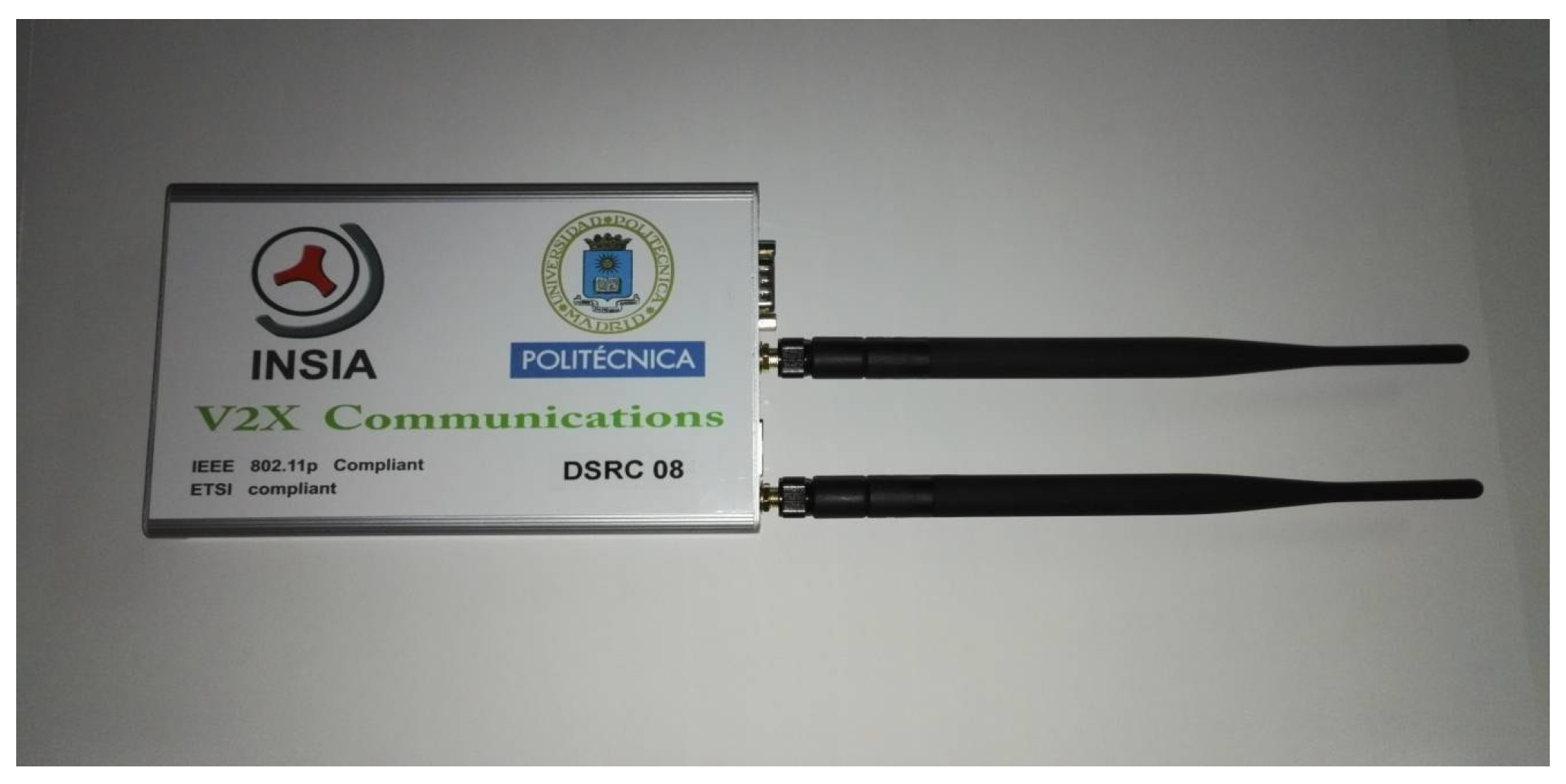

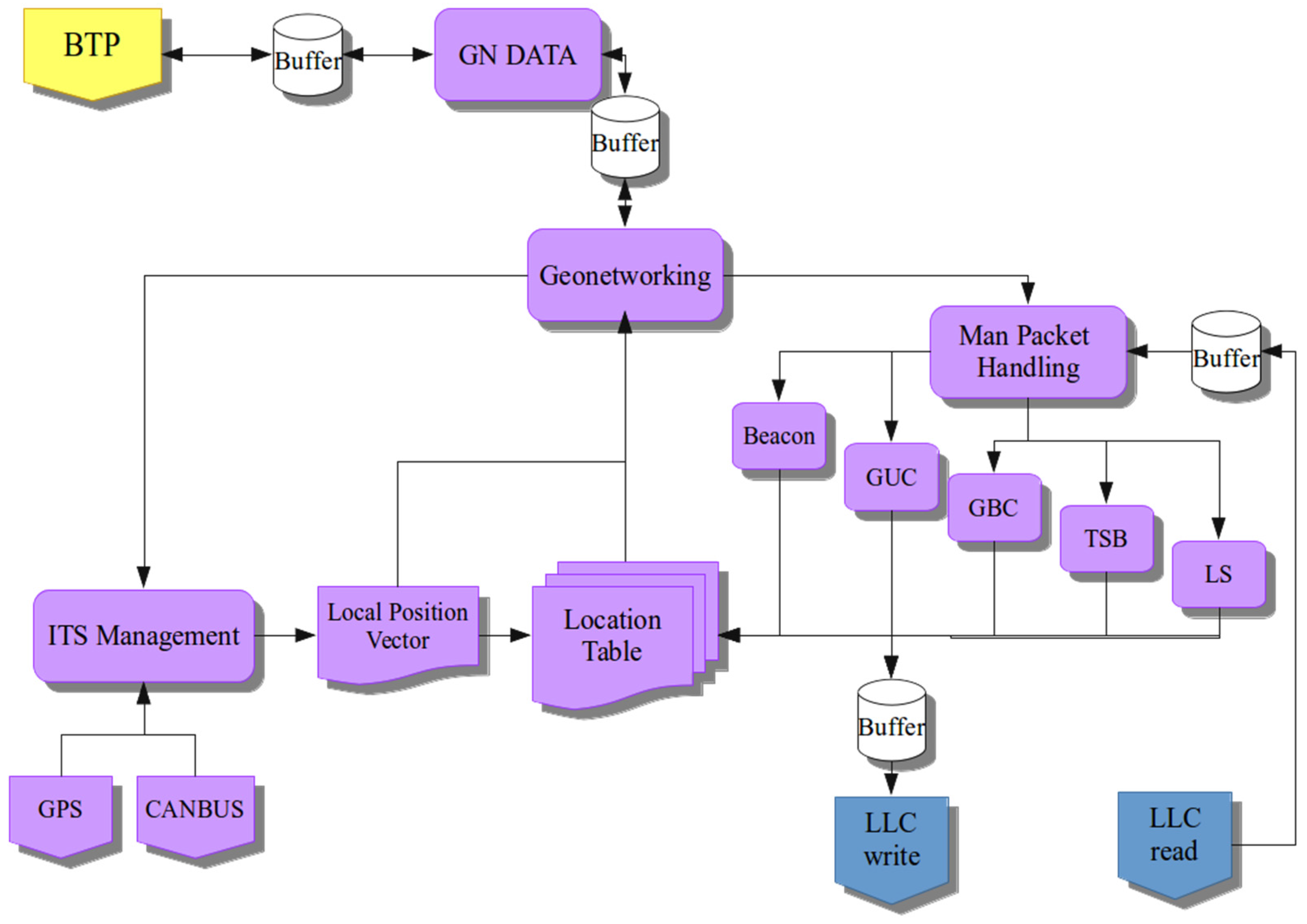
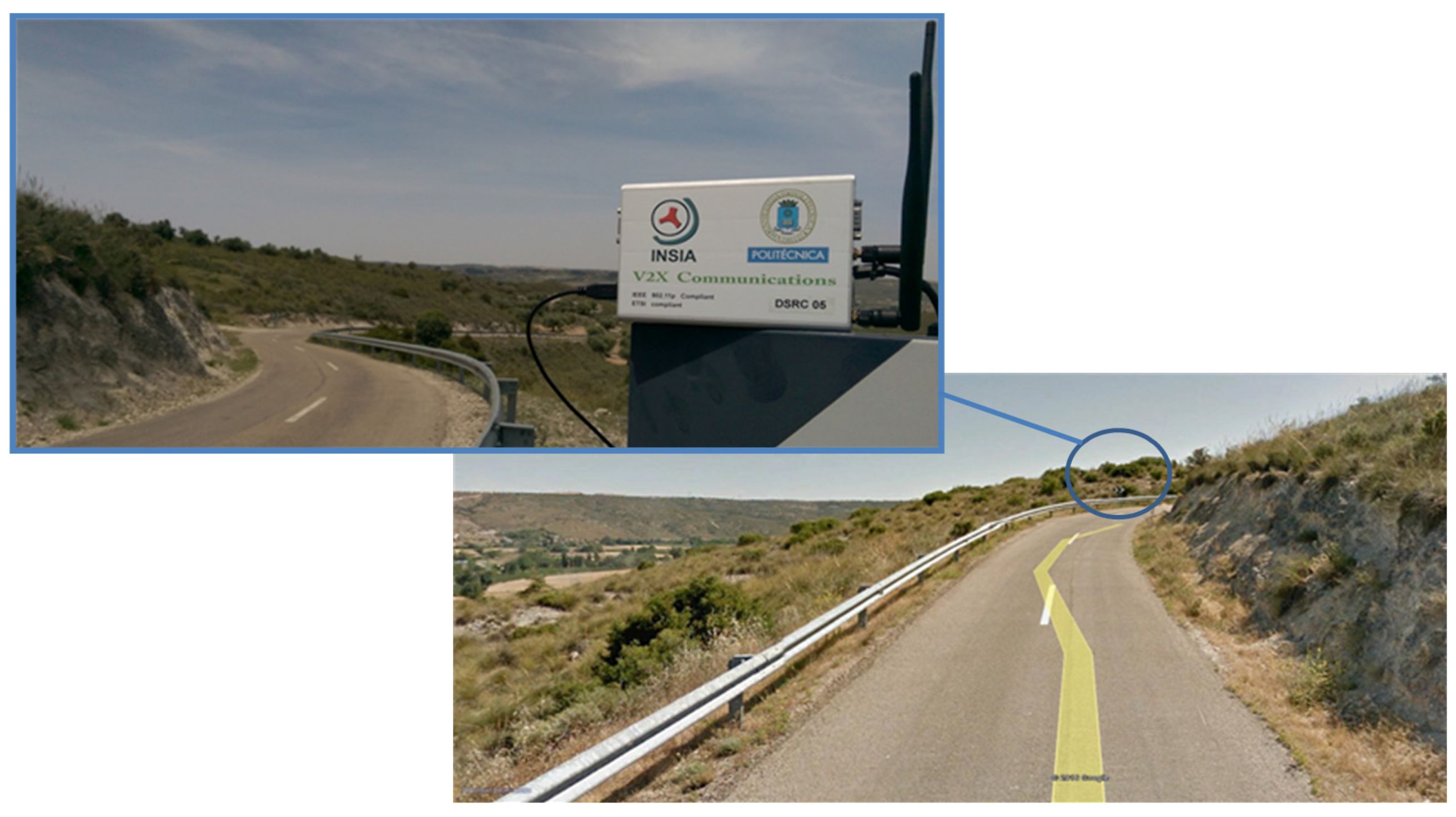
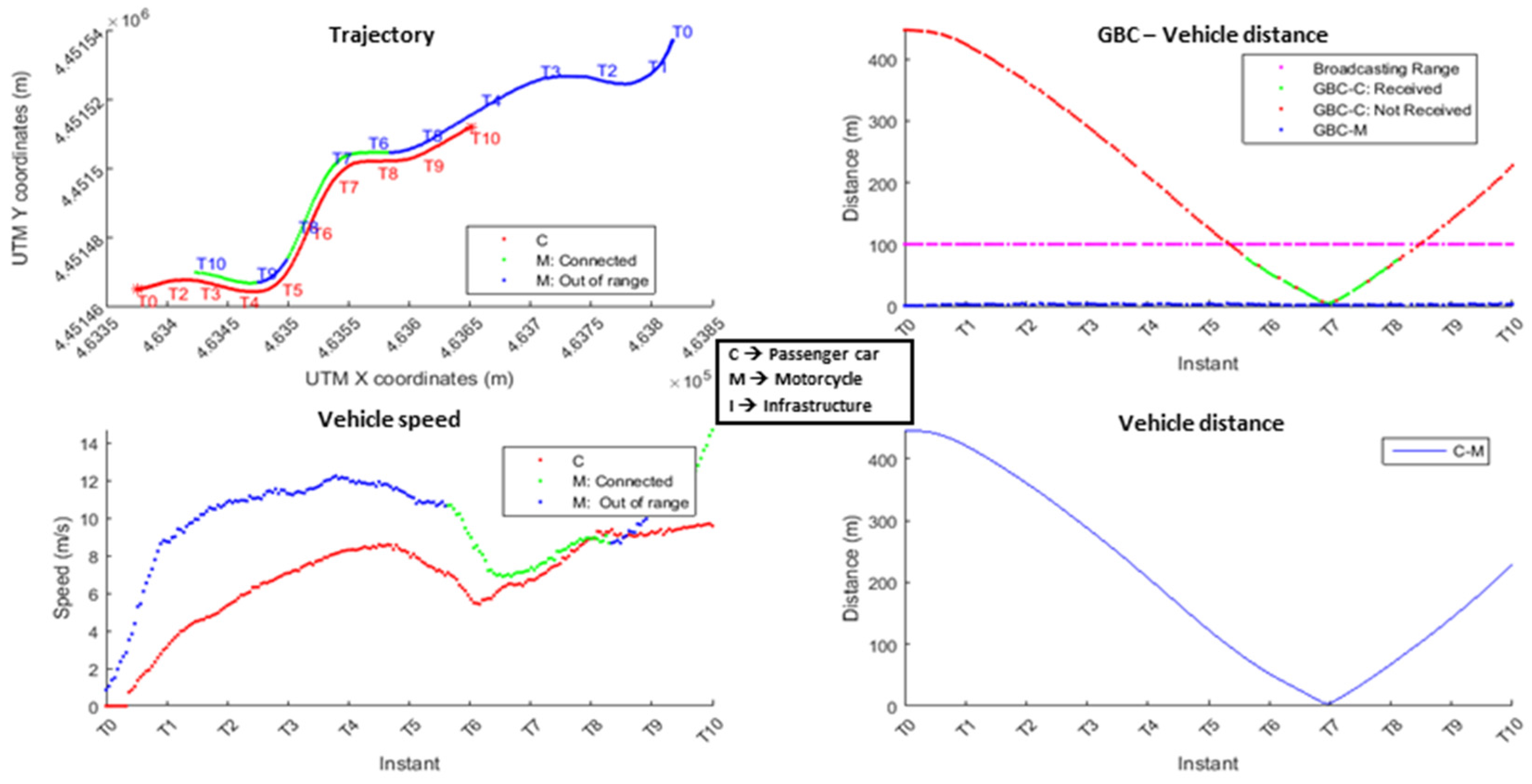

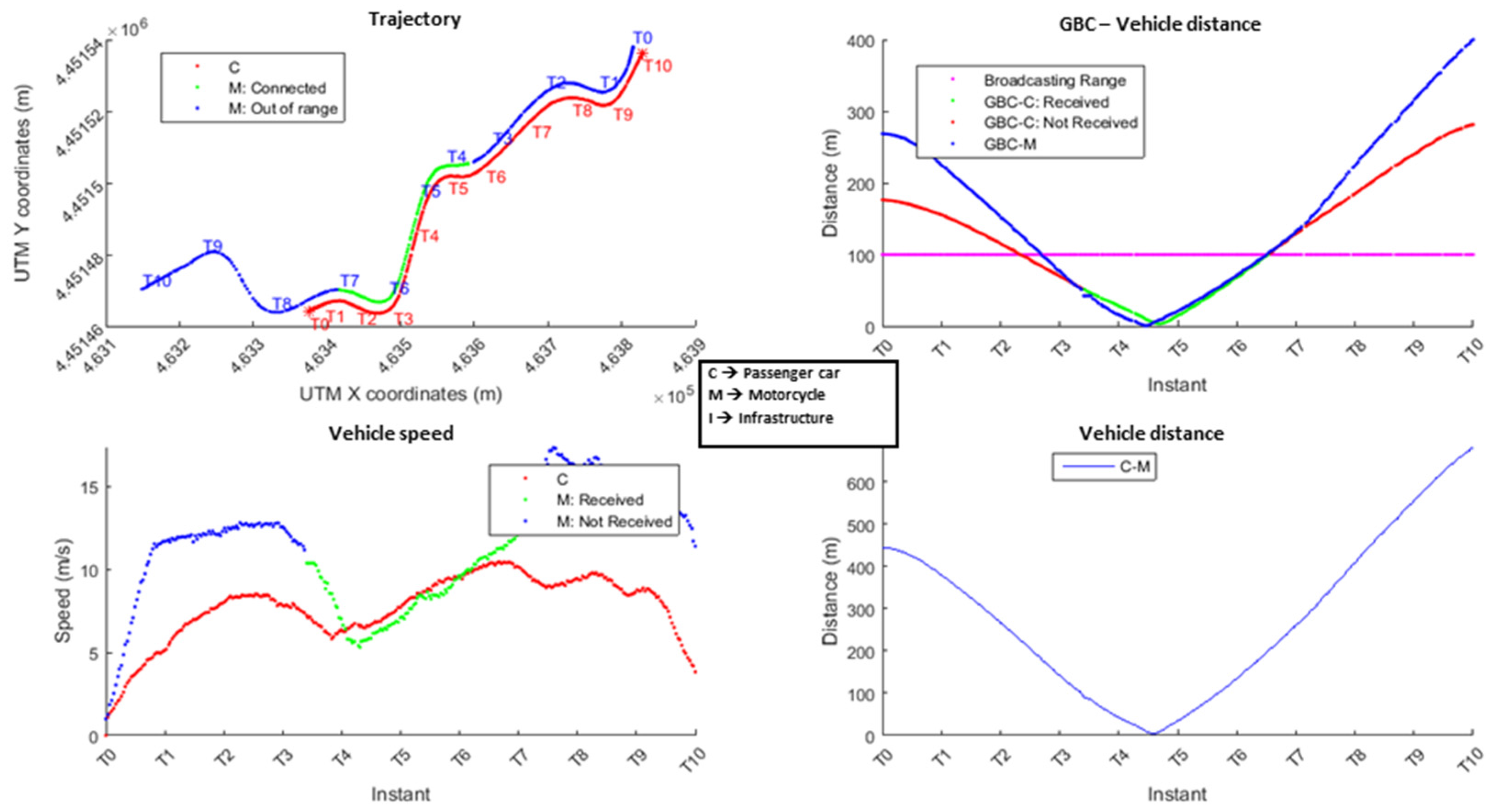
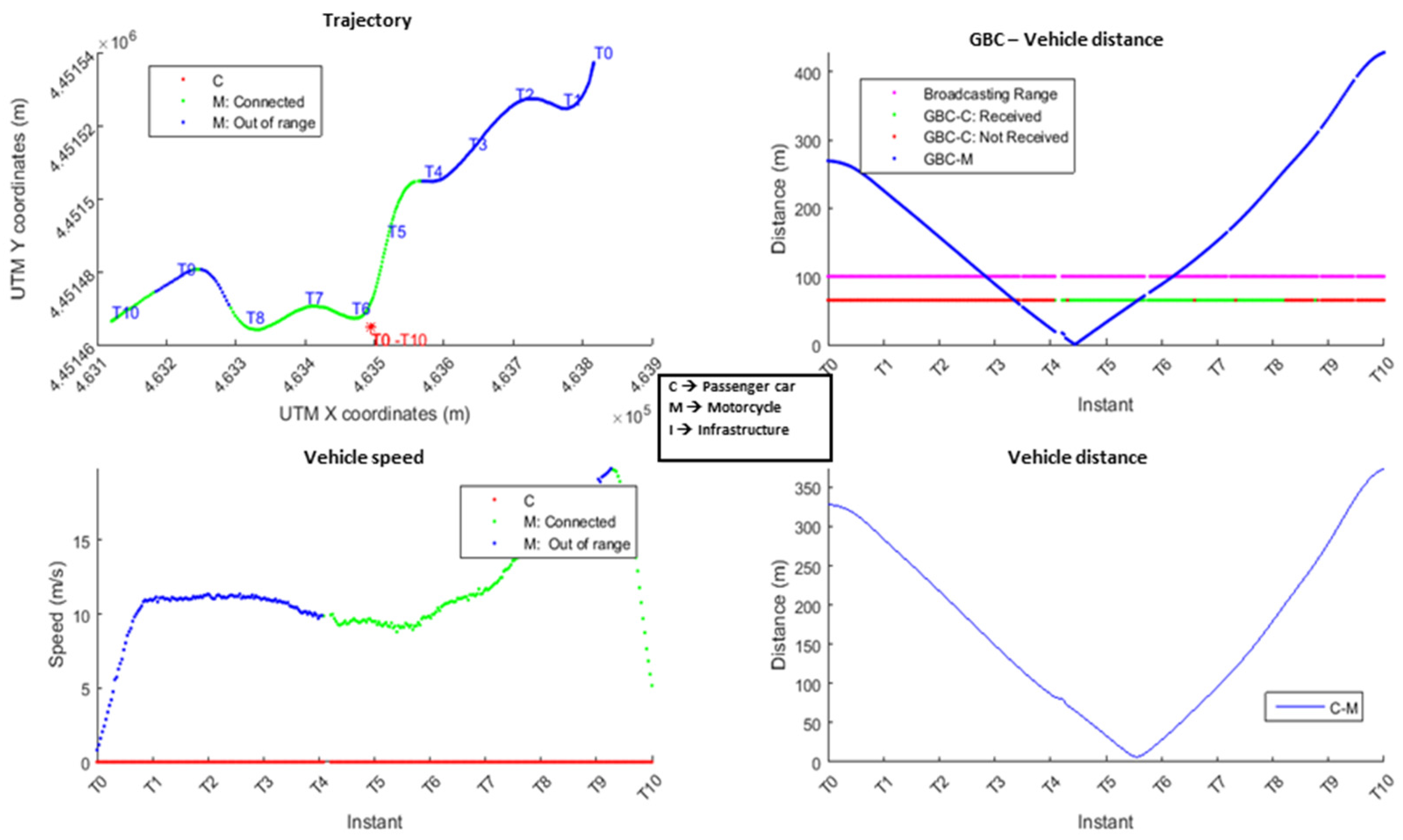
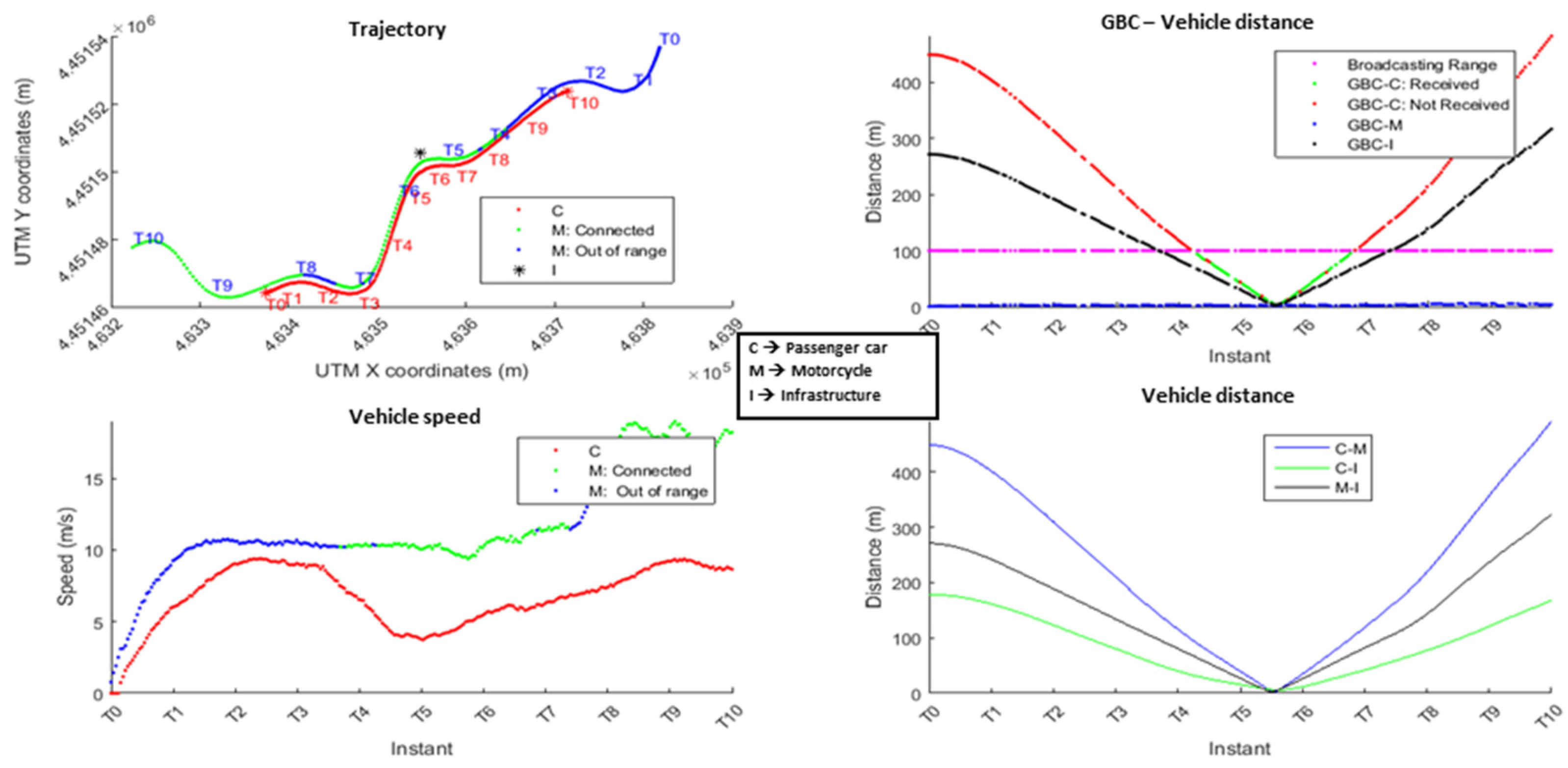


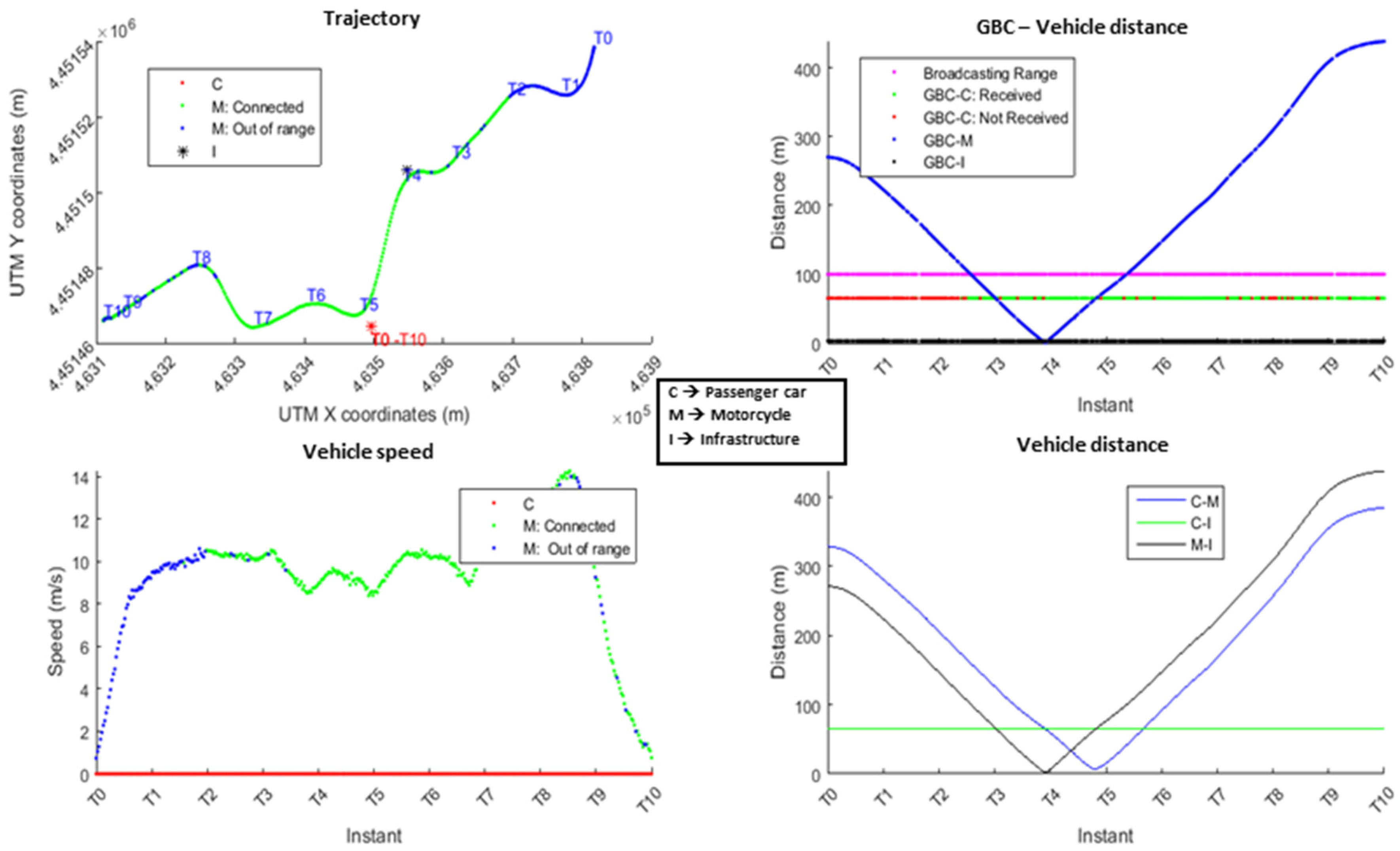
| Vehicle | GBC Characteristics | RSU | |
|---|---|---|---|
| Test 1A | Stopped | Over the motorcycle | NO |
| Test 1B | Stopped | Over the motorcycle | YES |
| Test 2A | Moving | Over the motorcycle | NO |
| Test 2B | Moving | Over the motorcycle | YES |
| Test 3A | Stopped | Over the vertex of the curve | NO |
| Test 3B | Stopped | Over the vertex of the curve | YES |
| Test 4A | Moving | Over the vertex of the curve | NO |
| Test 4B | Moving | Over the vertex of the curve | YES |
| Distance (Meters) | RSU | Transmission Delay | |
|---|---|---|---|
| Test 1A | 80 m | No | <1 ms |
| Test 1B | 150 m | Yes | <1 ms |
| Test 2A | 60 m | No | <1 ms |
| Test 2B | 150 m | Yes | <1 ms |
| Test 3A | 74 m | No | <1 ms |
| Test 3B | 190 m | Yes | <1 ms |
| Test 4A | 70 m | No | <1 ms |
| Test 4B | 210 m | Yes | <1 ms |
| GBC Packets Sent | GBC Packets Sent When the Car Is Inside the Transmission Area | GBC Packets Received by the Car | GBC Packets Not Received Rate | Time Connected | |
|---|---|---|---|---|---|
| Test 1A | 247 | 87 | 65 | 25.3% | 29.8 s |
| Test 1B | 301 | 100 | 88 | 12% | 43 s |
| Test 2A | 179 | 59 | 43 | 27.1% | 15.6 s |
| Test 2B | 224 | 61 | 53 | 13.1% | 29.4 s |
| Test 3A | 308 | 308 | 124 | 59.7% | 36 s |
| Test 3B | 365 | 365 | 253 | 30.6% | 56.2 s |
| Test 4A | 246 | 127 | 61 | 51.9% | 22.4 s |
| Test 4B | 272 | 113 | 109 | 4.4% | 34.6 s |
© 2018 by the authors. Licensee MDPI, Basel, Switzerland. This article is an open access article distributed under the terms and conditions of the Creative Commons Attribution (CC BY) license (http://creativecommons.org/licenses/by/4.0/).
Share and Cite
Talavera, E.; Anaya, J.J.; Gómez, O.; Jiménez, F.; Naranjo, J.E. Performance Comparison of Geobroadcast Strategies for Winding Roads. Electronics 2018, 7, 32. https://doi.org/10.3390/electronics7030032
Talavera E, Anaya JJ, Gómez O, Jiménez F, Naranjo JE. Performance Comparison of Geobroadcast Strategies for Winding Roads. Electronics. 2018; 7(3):32. https://doi.org/10.3390/electronics7030032
Chicago/Turabian StyleTalavera, Edgar, José J. Anaya, Oscar Gómez, Felipe Jiménez, and José E. Naranjo. 2018. "Performance Comparison of Geobroadcast Strategies for Winding Roads" Electronics 7, no. 3: 32. https://doi.org/10.3390/electronics7030032





